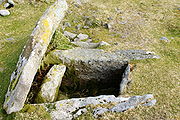
Cist
Encyclopedia


Ossuary
An ossuary is a chest, building, well, or site made to serve as the final resting place of human skeletal remains. They are frequently used where burial space is scarce. A body is first buried in a temporary grave, then after some years the skeletal remains are removed and placed in an ossuary...
used to hold the bodies of the dead. Examples can be found across Europe and in the Middle East.
A cist may have been associated with other monuments, perhaps under a cairn
Cairn
Cairn is a term used mainly in the English-speaking world for a man-made pile of stones. It comes from the or . Cairns are found all over the world in uplands, on moorland, on mountaintops, near waterways and on sea cliffs, and also in barren desert and tundra areas...
or long barrow
Tumulus
A tumulus is a mound of earth and stones raised over a grave or graves. Tumuli are also known as barrows, burial mounds, Hügelgrab or kurgans, and can be found throughout much of the world. A tumulus composed largely or entirely of stones is usually referred to as a cairn...
. It would not be uncommon to find several cists close together within the same cairn or barrow. Often ornaments have been found within an excavated cist, indicating the wealth or prominence of the interred individual.
In Devonshire a local word for a cist in Modern Cornish
Cornish language
Cornish is a Brythonic Celtic language and a recognised minority language of the United Kingdom. Along with Welsh and Breton, it is directly descended from the ancient British language spoken throughout much of Britain before the English language came to dominate...
is kistvaen
Kistvaen
A kistvaen or cistvaen is a tomb or burial chamber formed from flat stone slabs in a box-like shape. If set completely underground, it may be covered by a tumulus. The word is derived from the Welsh cist and maen...
. There are numerous Dartmoor kistvaens
Dartmoor kistvaens
Dartmoor kistvaens are burial tombs or cists from the Neolithic age, i.e. they are approximately 4,000 years old. Kistvaens have been found in many places, including Dartmoor, a 954 square kilometre area of moorland in south Devon, England. The box-like stone tombs were created when the ancient...
.
In the Welsh language
Welsh language
Welsh is a member of the Brythonic branch of the Celtic languages spoken natively in Wales, by some along the Welsh border in England, and in Y Wladfa...
who's origins, like Cornish is from the ancient British or Brythonic language line, 'Cist' is also used for such ancient graves, but in modern use, can also mean a chest, a coffer, a box, or even the boot / trunk of a car.
Regional examples
Scotland- Balblair cist, BeaulyBeaulyBeauly is a town of the Scottish county of Inverness-shire, on the River Beauly, 10 miles west of Inverness by the Far North railway line. Its population was 855 in 1901...
, Inverness - Dunan AulaDunan AulaDunan Aula, also known in Scottish Gaelic as Dùnan Amhlaidh, is the site of an exposed cist, located in the parish of Craignish, in Argyll and Bute, Scotland. The site is located at...
, Craignish, Argyll and Bute - HolmHolm, InvernessHolm is a small residential area in the south of the city of Inverness, Scotland. Holm is middle English and Norse, meaning "low lying land next to water". The area lies East of the River Ness....
Mains Farm, Inverness

